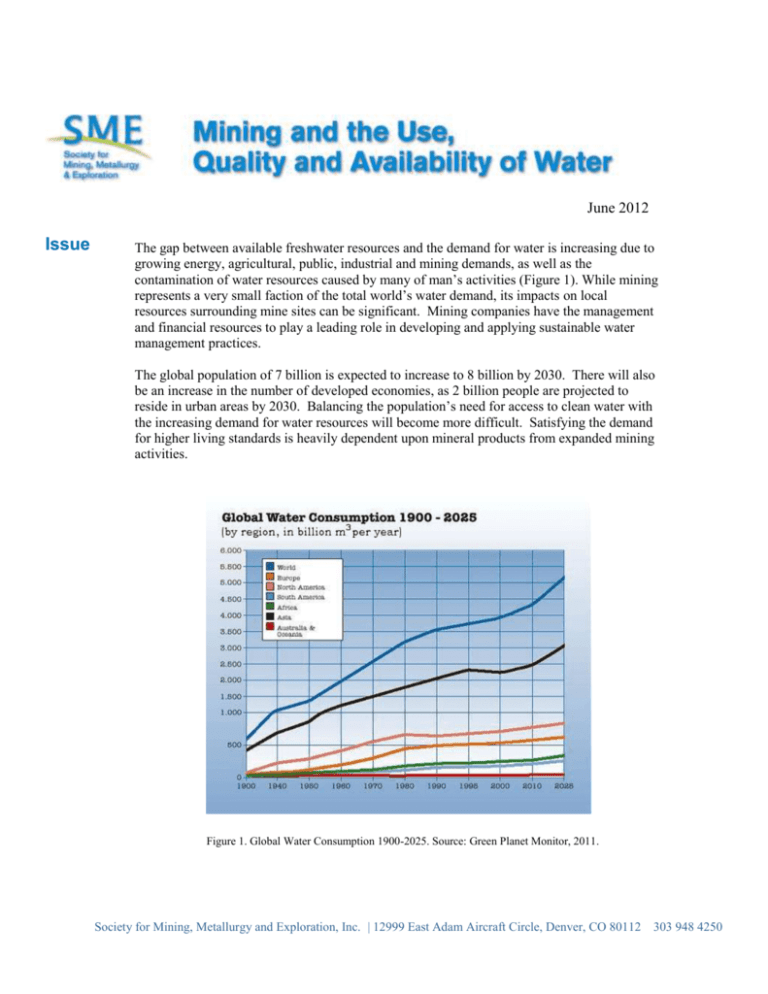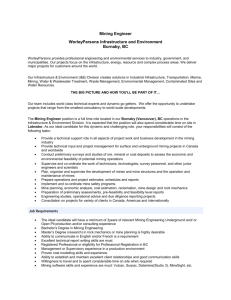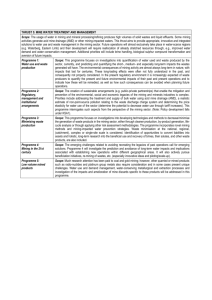Issue
advertisement

June 2012 Issue The gap between available freshwater resources and the demand for water is increasing due to growing energy, agricultural, public, industrial and mining demands, as well as the contamination of water resources caused by many of man’s activities (Figure 1). While mining represents a very small faction of the total world’s water demand, its impacts on local resources surrounding mine sites can be significant. Mining companies have the management and financial resources to play a leading role in developing and applying sustainable water management practices. The global population of 7 billion is expected to increase to 8 billion by 2030. There will also be an increase in the number of developed economies, as 2 billion people are projected to reside in urban areas by 2030. Balancing the population’s need for access to clean water with the increasing demand for water resources will become more difficult. Satisfying the demand for higher living standards is heavily dependent upon mineral products from expanded mining activities. Figure 1. Global Water Consumption 1900-2025. Source: Green Planet Monitor, 2011. Society for Mining, Metallurgy and Exploration, Inc. | 12999 East Adam Aircraft Circle, Denver, CO 80112 303 948 4250 Extraction and processing of mined materials generally requires water (Figure 2). Water is also the primary vehicle by which mining related contaminates can inadvertently be transported into the environment and worsen the quality of water resources. Water use and potential environmental impacts to surface and ground water vary greatly and depend on the size of the mine, its proximity to water resources, the commodity mined (base or precious metals, coal, industrial minerals, aggregates, etc.), the method of ore processing (crushing, screening, washing, flotation, leaching), and the mining method (underground, solution, open pit, or dredging). Potential mining-related impacts include both physical and chemical degradation of surface and ground waters. These impacts include sediment discharge and deposition in rivers and lakes and discharges of salty or acidic waters that can often contain dissolved metals and others mine-related constituents. Background The major public concerns with mining include the potential local impacts due to water withdrawal from surface and ground water resources and the formation of acid rock drainage (ARD). ARD results from the reaction of water and air containing oxygen with sulfide and other minerals contained in mined rock. It leads to acidic waters that mobilize toxic metals, sulfates and dissolved solids. Figure 2. Estimated use of water in the United States in 2005: U.S. Geological Survey Circular 1344, 2009. Society for Mining, Metallurgy and Exploration, Inc. | 12999 East Adam Aircraft Circle, Denver, CO 80112 303 948 4250 Figure 3. Estimated use of water in the United States, USGS, 2005 In the U.S. during 2005, an estimated 4 billion gallons per day (Bgal/d) was withdrawn for mining purposes, as compared to 3.8 Bgal/day for domestic use, 201 Bgal/day used for thermoelectric plants and 128 Bgal/d was consumed for agricultural use (Figure 3). Mining withdrawals were about 1 percent of total withdrawals or 2 percent if thermoelectric power generation is excluded (Figure 4). Figure 4. A Strategy for Federal Science and Technology to Support Water Availability and Quality in the United States, National Science and Technology Council, 2007. The legacy of historic mining in the United States includes more than 96,000 abandoned or inactive mines or features (BLM, 2011). Nearly all of these were operated before modern day mining and environmental controls were instituted. Many of these abandoned mines have the potential for ARD or other processes that can cause water quality impacts. Society for Mining, Metallurgy and Exploration, Inc. | 12999 East Adam Aircraft Circle, Denver, CO 80112 303 948 4250 Water quality control options include locating mine wastes in areas with limited usable water resources, the use of waste containment and isolation features such as liners, caps, leachate collection systems, run-on and run-off controls; subaqueous disposal of tailings and other mined materials; mine water controls such as grout curtains, bulkheads, drainage tunnels and extraction wells; and water collection and treatment. While these options generally apply to existing and new mines, several of them are applicable to historic mines. Important elements of modern mine permitting include assuring the public and government agencies that the potential for water quality impacts is clearly understood and disclosed and that sound water management practices have been incorporated in the planning, design and closure of the new mine. During operations, mines also have the regulatory and social responsibility to monitor and report on the effectiveness of the water management procedures. SME Statement Of Technical Position The management of water during mining includes dewatering of the mine, the use of water in milling and processing operations, and the discharge of treated water to surface or ground water. Mines consume a small proportion of the water they use for their processes. The amount of water consumed in the operation versus that requiring discharge varies depending on the site-specific climatic conditions and the size and type of the mining operation. Mines maximize recycling water from tailings impoundments and waste water collection ponds and also use the water that is removed from the mines themselves. After control and treatment mining operations are able to return the water to a surface source or re-inject it into the ground. Water discharged from mining operations must meet stringent water quality standards. Federal, state and local regulations govern mine waste and water management, as well as closure planning and post-closure mitigation and monitoring. Financial assurance requirements have also evolved to better accommodate the known costs of environmental cleanup and mine closure, including any post-closure water treatment requirements, which can be significant and long term. SME supports the goals to continually improve management of water at mines and minimize the effects of mining on both water quantity and quality by: Preventing or minimizing the migration of acid drainage and other mine-related contaminants to surface and ground water resources; Maximizing water recycling and minimizing water consumption during operations; Integrating pollution prevention and water conservation measures in mine planning, design and operation; Creating mines that are suitable for a variety of productive post-mining land uses. These goals can be achieved by: Facilitating research, education and training in scientific approaches to minimizing water use and improving water quality at mining operations; Developing additional water re-use technologies for water encountered at mine sites; Developing mine dewatering approaches that minimize water extraction rates and reduce water quality impacts; Promoting cooperation among international stakeholders engaged in scientific or engineering work in the field of mine water problems and related sciences; Promoting the exchange and publication of water-related scientific and engineering information. Society for Mining, Metallurgy and Exploration, Inc. | 12999 East Adam Aircraft Circle, Denver, CO 80112 303 948 4250








